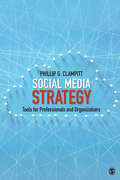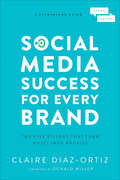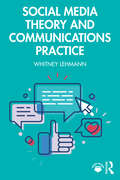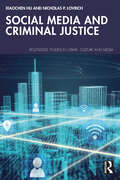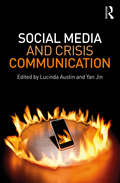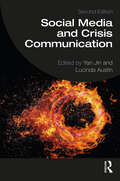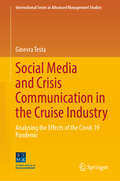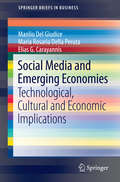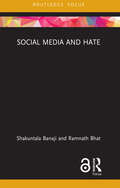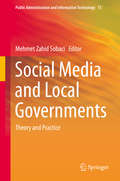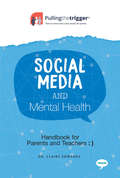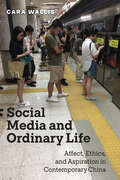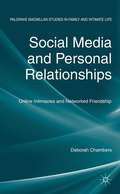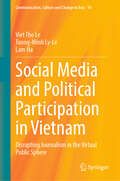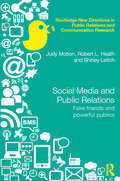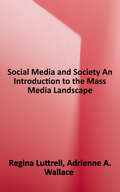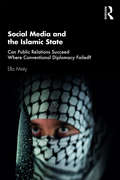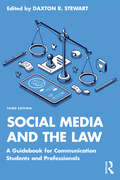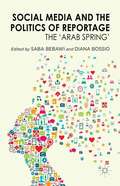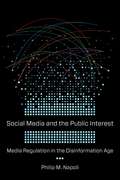- Table View
- List View
Social Media Strategy: Tools for Professionals and Organizations
by Phillip G. ClampittSocial Media Strategy: Tools for Professionals and Organizations, by Phillip G. Clampitt, shows professionals and organizations how to use social media more effectively and strategically. With a focus on what makes social media unique among communication platforms, this book offers practical guidance on creating, implementing, and evaluating social media strategies and tactics. Social media is constantly evolving, so Social Media Strategy focuses on enduring strategic principles and uses case studies and exercises throughout to help readers build the fundamental competencies needed by today’s social media managers.
Social Media Strategy: Tools for Professionals and Organizations
by Phillip G. ClampittSocial Media Strategy: Tools for Professionals and Organizations, by Phillip G. Clampitt, shows professionals and organizations how to use social media more effectively and strategically. With a focus on what makes social media unique among communication platforms, this book offers practical guidance on creating, implementing, and evaluating social media strategies and tactics. Social media is constantly evolving, so Social Media Strategy focuses on enduring strategic principles and uses case studies and exercises throughout to help readers build the fundamental competencies needed by today’s social media managers.
Social Media Success for Every Brand: The Five Pillars That Turn Posts into Profits (The StoryBrand Guides)
by Claire Diaz-OrtizBased on Donald Miller&’s bestselling book?Building a StoryBrand, Claire Diaz-Ortiz applies the seven principles of the StoryBrand Framework to help you build an effective, long-lasting social media plan for your brand.Most business owners are blindly guessing at their social media strategy, and it&’s costing them time and money. This book teaches you how to incorporate the StoryBrand 7-Part Framework into their social media channels to increase engagement and see better results.In Social Media Success for Every Brand, you will understand exactly what they need to do with their social media to drive growth to their organization through the practical guidance of the five-point SHARE model:StoryHowAudienceReachExcellenceSocial Media Success for Every Brand does not require you to be familiar with?Building a StoryBrand,?but provides enough foundation to prepare you for practical success with their social media content.Together with the StoryBrand Framework, Claire&’s SHARE model will help boost customer engagement and grow the organization&’s brand awareness and revenues.
Social Media Theory and Communications Practice
by Whitney LehmannFusing the academic with the applied, this book provides a comprehensive introduction to social media for future communications professionals. While most social media texts approach the subject through either a theoretical, scholarly lens or a professional, practical lens, this text offers a much-needed linkage of theory to the practical tactics employed by social media communicators. Concise and conversational chapters break down the basics of both social media theory and practice and are complemented by sidebars written by scholars and industry professionals, chapter summaries and end-of-chapter exercises. This book is ideal for introductory social media courses in communication, public relations and mass communication departments, as well as courses in digital media and public relations. Online resources include social media writing templates, sample posts and content calendar templates. Please visit www.routledge.com/9781032185873.
Social Media Theory and Communications Practice
by Whitney LehmannFusing the academic with the applied, this book provides a comprehensive introduction to social media for future communications professionals.While most social media texts approach the subject through either a theoretical, scholarly lens or a professional, practical lens, this text offers a much-needed linkage of theory to the practical tactics employed by social media communicators. Concise and conversational chapters break down the basics of both social media theory and practice and are complemented by sidebars written by scholars and industry professionals, chapter summaries and end-of-chapter exercises.This book is ideal for introductory social media courses in communication, public relations and mass communication departments, as well as courses in digital media and public relations.Online resources include social media writing templates, sample posts and content calendar templates. Please visit www.routledge.com/9781032185873.
Social Media and Criminal Justice (Routledge Studies in Crime, Culture and Media)
by Nicholas P. Lovrich Xiaochen HuDiscussing social media-related scholarship found in criminology, legal studies, policing, courts, corrections, victimization, and crime prevention, this book presents the current state of our knowledge on the impact of social media and the major sociological frameworks employed to study the U.S. justice system.Building a theoretical framework for the study of social media and criminal justice in each chapter, the chapters provide a systematic reflection of extant research on social media in cybercrime, operations of courts, administration of institutional and community corrections, law enforcement, and crime prevention. The book fills the gap between the contemporary state of knowledge regarding social media and criminal justice with respect to both empirical evidence and types of sociological frameworks being employed to explore and identify the societal costs and benefits of our growing dependence upon social media. In addition to providing an up-to-date overview of our current state of knowledge, this book highlights important areas of future research, wherein the benefits of social media can be expanded and the negative aspects of its broadening use can be minimized.Social Media and Criminal Justice will be of interest to students, scholars and practitioners in the areas of judicial administration, corrections management, law enforcement, and criminal justice-engaged community-based nonprofit organizations involved in court-referred treatment and/or active collaboration with local law enforcement agencies.
Social Media and Crisis Communication
by Lucinda L. Austin Yan JinSocial Media and Crisis Communication provides a unique and timely contribution to the field of crisis communication by addressing how social media are influencing the practice of crisis communication. The book, with a collection of chapters contributed by leading communication researchers, covers the current and emerging interplay of social media and crisis communication, recent theories and frameworks, overviews of dominant research streams, applications in specific crisis areas, and future directions. Both the theoretical and the practical are discussed, providing a volume that appeals to both academic-minded readers as well as professionals at the managerial, decision-making level. The audience includes public relations and corporate communication scholars, graduate students studying social media and crisis communication, researchers, crisis managers working in communication departments, and business leaders who make strategic business communication planning. No other volume has provided the overarching synthesis of information regarding the field of crisis communication and social media that this book contains. Incorporated in this volume is the recent Social-mediated Crisis Communication Model developed by the editors and their co-authors, which serves as a framework for crisis and issues management in a rapidly evolving media landscape.
Social Media and Crisis Communication
by Yan JinThe second edition of this vital text integrates theory, research, and application to orient readers to the latest thinking about the role of social media in crisis communication. Specific crisis arenas such as health, corporate, nonprofit, religious, political, and disaster are examined in depth, along with social media platforms and newer technology. Social Media and Crisis Communication, Second Edition provides a fresh look at the role of visual communication in social media and a more global review of social media and crisis communication literature. With an enhanced focus on the ethics section, a short communication overview piece, and case studies for each area of application, it is practical for use in a variety of learning settings. A must-read for scholars, advanced students, and practitioners who wish to stay on the leading edge of research, this book will appeal to those in public relations, strategic communications, corporate communications, government and NGO communications, and emergency and disaster response.
Social Media and Crisis Communication in the Cruise Industry: Analysing the Effects of the Covid-19 Pandemic (International Series in Advanced Management Studies)
by Ginevra TestaThis academic monograph examines the crisis communication response strategies employed by the cruise industry on social media following the COVID-19 pandemic. Focusing on social media platform X, the author conducted a content analysis of the top three cruise lines' strategies using NVivo software and assessed public sentiment and emotions through comments using KNIME and R software. The findings identify the most effective strategies for generating positive public sentiment and favourable emotions, contributing to faster business recovery. The book enhances Situational Crisis Communication Theory and offers practical guidance for managers to improve crisis resilience in the face of crises of such magnitude and duration. This work uniquely combines corporate and consumer perspectives to assess the effectiveness of crisis communication.
Social Media and Electronic Commerce Law
by Alan DavidsonThe ever-evolving nature of electronic commerce and social media continues to challenge the capacity of the courts to respond to privacy and security violations in 'cyberlaw'. Social Media and Electronic Commerce Law is designed to provide students and legal practitioners with a thorough and engaging exploration of the laws, regulations and grey areas of commerce via online platforms. This new edition has been thoroughly revised to address changes in legislation and recent court judgments, and to reflect the dynamic sphere of social media. New chapters focus on internet and e-commerce law regarding social media, P2P file sharing, Cloud computing and workplace issues, with an emphasis on data security made particularly relevant by the proliferation of hacking incidents. Written in an accessible style, Social Media and Electronic Commerce Law investigates the challenges facing legal practitioners and commercial parties in this dynamic field, as well as the underlying legal theory that governs it.
Social Media and Emerging Economies
by Maria Rosaria Della Peruta Manlio Del Giudice Elias G. CarayannisHow have social media in emerging economies evolved differently from the rest of the world? According to studies and anecdotal evidence, innovations in the use of social media tools occur more frequently in emerging economies than they do in developed markets. The aim of this volume is to show that in emerging regions (such as China, India, and South America) where the participation of stakeholders in the circuit of social media is more active (i. e. , greater frequency of contacts and creativity in the elaboration of contents), organizations not only are involved in a set of exchange relations with other social actors but are also embedded in a network of dynamic relationships. The authors utilize social network analysis to determine how entrepreneurs in emerging economies identify their most beneficial social contacts and use those contacts to leverage the resources needed for their enterprises, revealing new insights on the process of business creation and economic development in the networked age.
Social Media and Hate (Routledge Focus on Communication and Society)
by Shakuntala Banaji Ramnath BhatUsing expert interviews and focus groups, this book investigates the theoretical and practical intersection of misinformation and social media hate in contemporary societies. Social Media and Hate argues that these phenomena, and the extreme violence and discrimination they initiate against targeted groups, are connected to the socio-political contexts, values and behaviours of users of social media platforms such as Facebook, TikTok, ShareChat, Instagram and WhatsApp. The argument moves from a theoretical discussion of the practices and consequences of sectarian hatred, through a methodological evaluation of quantitative and qualitative studies on this topic, to four qualitative case studies of social media hate, and its effects on groups, individuals and wider politics in India, Brazil, Myanmar and the UK. The technical, ideological and networked similarities and connections between social media hate against people of African and Asian descent, indigenous communities, Muslims, Dalits, dissenters, feminists, LGBTQIA communities, Rohingya and immigrants across the four contexts is highlighted, stressing the need for an equally systematic political response. This is an insightful text for scholars and academics in the fields of Cultural Studies, Community Psychology, Education, Journalism, Media and Communication Studies, Political Science, Social Anthropology, Social Psychology, and Sociology.
Social Media and Local Governments
by Mehmet Zahid SobaciToday, social media have attracted the attention of political actors and administrative institutions to inform citizens as a prerequisite of open and transparent administration, deliver public services, contact stakeholders, revitalize democracy, encourage the cross-agency cooperation, and contribute to knowledge management. In this context, the social media tools can contribute to the emergence of citizen-oriented, open, transparent and participatory public administration. Taking advantage of the opportunities offered by social media is not limited to central government. Local governments deploy internet-based innovative technologies that complement traditional methods in implementing different functions. This book focuses on the relationship between the local governments and social media, deals with the change that social media have caused in the organization, understanding of service provision, performance of local governments and in the relationships between local governments and their partners, and aims to advance our theoretical and empirical understanding of the growing use of social media by local governments. This book will be of interest to researchers and students in e-government, public administration, political science, communication, information science, and social media. Government officials and public managers will also find practical use recommendations for social media in several aspects of local governance
Social Media and Mental Health: Handbook for Parents and Teachers (Pulling the Trigger)
by Claire EdwardsSocial Media and Mental Health: Handbook for Parents and Teachers will help you navigate the tricky waters surrounding your child’s use of the internet. Written by Clare Edwards, a clinical psychologist experienced in the field of adolescent mental health, it will highlight the challenges of parenting in the digital age, and offer tips and advice on how to keep your children safe online. Most importantly, this quick and easy illustrated guide explores the impact of social media on children's mental health, providing tools for ensuring that your child has a healthy relationship with social media and the internet.
Social Media and Ordinary Life: Affect, Ethics, and Aspiration in Contemporary China (Critical Cultural Communication)
by Cara WallisHow Chinese citizens use social mediaFocusing on domestic workers, rural microentrepreneurs, disadvantaged young creatives, and young feminists, Social Media and Ordinary Life is a deeply moving ethnography of how digital media infrastructures and platforms are woven into the rhythms of ordinary, everyday life. In choosing to foreground marginalized groups and communities, Cara Wallis gently shifts our attention away from the world of “social media influencers” and tech-centric discourses of entrepreneurial lives towards a decidedly ambivalent terrain of routine life practices.Social Media and Ordinary Life argues that understanding these individual experiences of the everyday enables greater insight into larger transformations taking place in contemporary China. Through long-term ethnographic fieldwork across China, Wallis foregrounds the entanglement of affect, emotion, ordinary ethical decisions, and desires connected to social media as it is used for self-expression, self-representation, fights for equality, maintenance of community, and economic livelihood. Four case studies show how social media is integrated into the articulation of affects by a wide variety of “ordinary” Chinese subjects: disadvantaged young creatives who migrate to Beijing from rural areas and use social media to cultivate their personal aesthetics; micro-entrepreneurs in rural Shandong province, especially women whose affective ties to the patriarchal family constrain their use of technology for economic enhancement; domestic workers, all women, in urban homes who use social media to build community and construct themselves as ethical subjects; and young feminists spread across China who engage in various types of cultural production and deploy social media in their fight for gender equality, often facing social and/or political marginalization in the process.Amid daunting forces—big data, artificial intelligence, massive surveillance—this book centers the “small,” showing how structural inequality, the urban/rural divide, patriarchal gender norms, and generational differences lead to contradictory or ambivalent outcomes of technology use. Even so, for these individuals and many others, social media is deeply intertwined with aspirations for a better future.
Social Media and Personal Relationships
by Deborah ChambersThis book explores how digital communication generates new intimacies and meanings of friendship in a networked society, developing a theory of mediated intimacies to explain how social media contributes to dramatic changes in our ideas about personal relationships, through themes of self, youth, families, digital dating and online social capital.
Social Media and Political Participation in Vietnam: Disrupting Journalism in the Virtual Public Sphere (Communication, Culture and Change in Asia #10)
by Viet Tho Le Tuong-Minh Ly-Le Lam HaThis book explores the nexus between social media use among young people and political participation in Vietnam, which presents a novel case example for examining whether social media can expand the public sphere to become involved in everyday politics. With an estimated 72 million Vietnamese on Facebook, the country is the seventh-largest user base in the world. This social media platform alone has created a virtual public sphere outside of and beyond the scope of the ruling Communist Party and its state-owned media outlets. The authors analyse the paradox of a complicated balancing act of digital participation in an authoritarian state, promoting a new understanding of social media in non-Western societies. The book generates a considerable body of empirical findings relating to political engagement amongst the youth in the digital age, and develops the theory of the public sphere beyond Habermas within this context. In its examination of the role of social media in society and in political communication generally, and the role of social media in authoritarian states, specifically, this book is of interest to students and scholars researching social media, political communication, and media theories. It is also relevant to those studying the intersection of media and politics in Southeast Asia, and in authoritarian states globally.
Social Media and Public Relations: Fake Friends and Powerful Publics (Routledge New Directions in PR & Communication Research)
by Robert L. Heath Judy Motion Shirley LeitchSocial media is having a profound, but not yet fully understood impact on public relations. In the 24/7 world of perpetually connected publics, will public relations function as a dark art that spins (or tweets) self-interested variations of the truth for credulous audiences? Or does the full glare of the internet and the increasing expectations of powerful publics motivate it to more honestly engage to serve the public interest? The purpose of this book is to examine the role of PR by exploring the myriad ways that social media is reshaping its conceptualization, strategies, and tactics. In particular, it explores the dichotomies of fake and authentic, powerless and powerful, meaningless and meaningful. It exposes transgressions committed by practitioners—the paucity of digital literacy, the lack of understanding of the norms of social media, naivety about corporate identity risks, and the overarching emphasis on spin over authentic engagement. But it also shows the power that closely networked social media users have to insert information and opinion into discussions and force "false PR friends" to be less so. This timely, challenging, and fascinating book will be of interest to all students, researchers, and practitioners in Public Relations, Media, and Communication Studies. Winner of the 2016 NCA PRIDE Award for best book
Social Media and Society: An Introduction to the Mass Media Landscape
by Regina Luttrell Adrienne A. WallaceRegina Luttrell and Adrienne A. Wallace present an engaging introduction to social media's integration with modern society. Recognizing categories of relational, societal, and self while analyzing the social media environment, this introductory mass communications textbook establishes a framework for understanding how technology, culture, democracy, economy, and audience fragmentation interact with each media industry differently and relate to media literacy. Armed with this knowledge, future professional communicators gain a better understanding of their audience and the level to which their strategies influence the public. The text empowers students as consumers and creators of social media and illustrates that, while the tools of communication have changed, the goals of social connection and influence have not. Features of this unique text include the following: - Relational/Societal/Self boxes provide a framework for analysis of media and society - In Theory boxes attaching theory to practice - Learning tools and enhanced pedagogy, such as Learning Objectives, Chapter Wrap-Up; Critical Thinking Questions, Media Sources, and End of Chapter Activities - Comprehensive Glossary of key terms - Full-color visuals capturing key trends and up-to-date data
Social Media and the Islamic State: Can Public Relations Succeed Where Conventional Diplomacy Failed?
by Ella MintyThis book examines how social media has transformed extremist discourse. Drawing on ISIS and their sophisticated use of social media platforms and PR concepts, it explores the ways in which the outfit was able to recruit, mobilise and spread fundamentalist propaganda in regions where it had little physical presence. One of the first studies to draw a link between international diplomacy, the rise of fundamentalism and public relations, this book will be of great interest to scholars and researchers of defence and strategic studies, especially those working on ISIS propaganda, Middle East Studies, media studies, digital humanities, communication studies, public relations and international relations, as well general readers.
Social Media and the Law: A Guidebook for Communication Students and Professionals
by Daxton R. StewartThis fully updated third edition of Social Media and the Law offers an essential guide to navigating the complex legal terrain of social media. Social media platforms like Facebook, Twitter, Instagram, YouTube, and TikTok have become vital tools for professionals in the news and strategic communication fields. As these services have rapidly grown in popularity, their legal ramifications have continued to develop, resulting in students and professional communicators needing to be aware of laws relating to defamation, privacy, intellectual property, and government regulation. Editor Daxton Stewart brings together eleven media law scholars to address key questions, such as the following: To what extent do communicators put themselves at risk for lawsuits when they use these tools? What rights do communicators have when other users talk about them on social networks? How can people and companies manage intellectual property issues consistent with the developing law in this area? This book is essential for students of media, mass communication, strategic communication, journalism, advertising, and public relations, as well as professional communicators that use social media in their role.
Social Media and the Politics of Reportage
by Saba Bebawi Diana BossioSocial Media and the Politics of Reportage explores the journalistic challenges, issues and opportunities that have risen as a result of social media increasingly being used as a form of crisis reporting within the field of global journalism, with a focus on the protests during the 'Arab Spring'.
Social Media and the Public Interest: Media Regulation in the Disinformation Age
by Philip M. NapoliFacebook, a platform created by undergraduates in a Harvard dorm room, has transformed the ways millions of people consume news, understand the world, and participate in the political process. Despite taking on many of journalism’s traditional roles, Facebook and other platforms, such as Twitter and Google, have presented themselves as tech companies—and therefore not subject to the same regulations and ethical codes as conventional media organizations. Challenging such superficial distinctions, Philip M. Napoli offers a timely and persuasive case for understanding and governing social media as news media, with a fundamental obligation to serve the public interest.Social Media and the Public Interest explores how and why social media platforms became so central to news consumption and distribution as they met many of the challenges of finding information—and audiences—online. Napoli illustrates the implications of a system in which coders and engineers drive out journalists and editors as the gatekeepers who determine media content. He argues that a social media–driven news ecosystem represents a case of market failure in what he calls the algorithmic marketplace of ideas. To respond, we need to rethink fundamental elements of media governance based on a revitalized concept of the public interest. A compelling examination of the intersection of social media and journalism, Social Media and the Public Interest offers valuable insights for the democratic governance of today’s most influential shapers of news.
Social Media at BBC News: The Re-Making of Crisis Reporting (Routledge Research in Journalism)
by Valerie Belair-GagnonSince the emergence of social media in the journalistic landscape, the BBC has sought to produce reporting more connected to its audience while retaining its authority as a public broadcaster in crisis reporting. Using empirical analysis of crisis news production at the BBC, this book shows that the emergence of social media at the BBC and the need to manage this kind of material led to a new media logic in which tech-savvy journalists take on a new centrality in the newsroom. In this changed context, the politico-economic and socio-cultural logic have led to a more connected newsroom involving this new breed of journalists and BBC audience. This examination of news production events shows that in the midst of transformations in journalistic practices and norms, including newsgathering, sourcing, distribution and impartiality, the BBC has reasserted its authority as a public broadcaster. Click here for a short video about the book.
